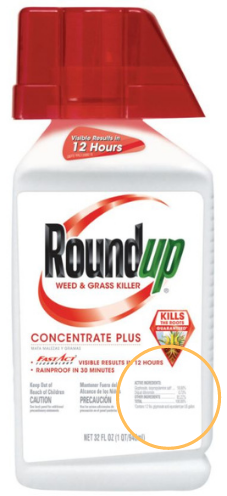Gateway on Pesticide Hazards and Safe Pest Management
How To Find Ingredients in Pesticide Products
Beyond Pesticides offers resources below to evaluate the health and ecological effects of specific chemical exposure from ACTIVE INGREDIENTS in pesticide products, as well as regulatory information and supporting scientific documents. Because various pesticide products can contain more than one active ingredient, it is important to READ the LABEL to determine chemical components.
With 192 different active ingredients and counting, it is essential to establish the connection between the use of these chemicals and their respective hazards.
View the step-by-step guide on how to search for the active ingredient(s) in pesticide products below:
- Go to U.S. EPA's Pesticide Product and Label System and enter the product name. The generic product name may vary.
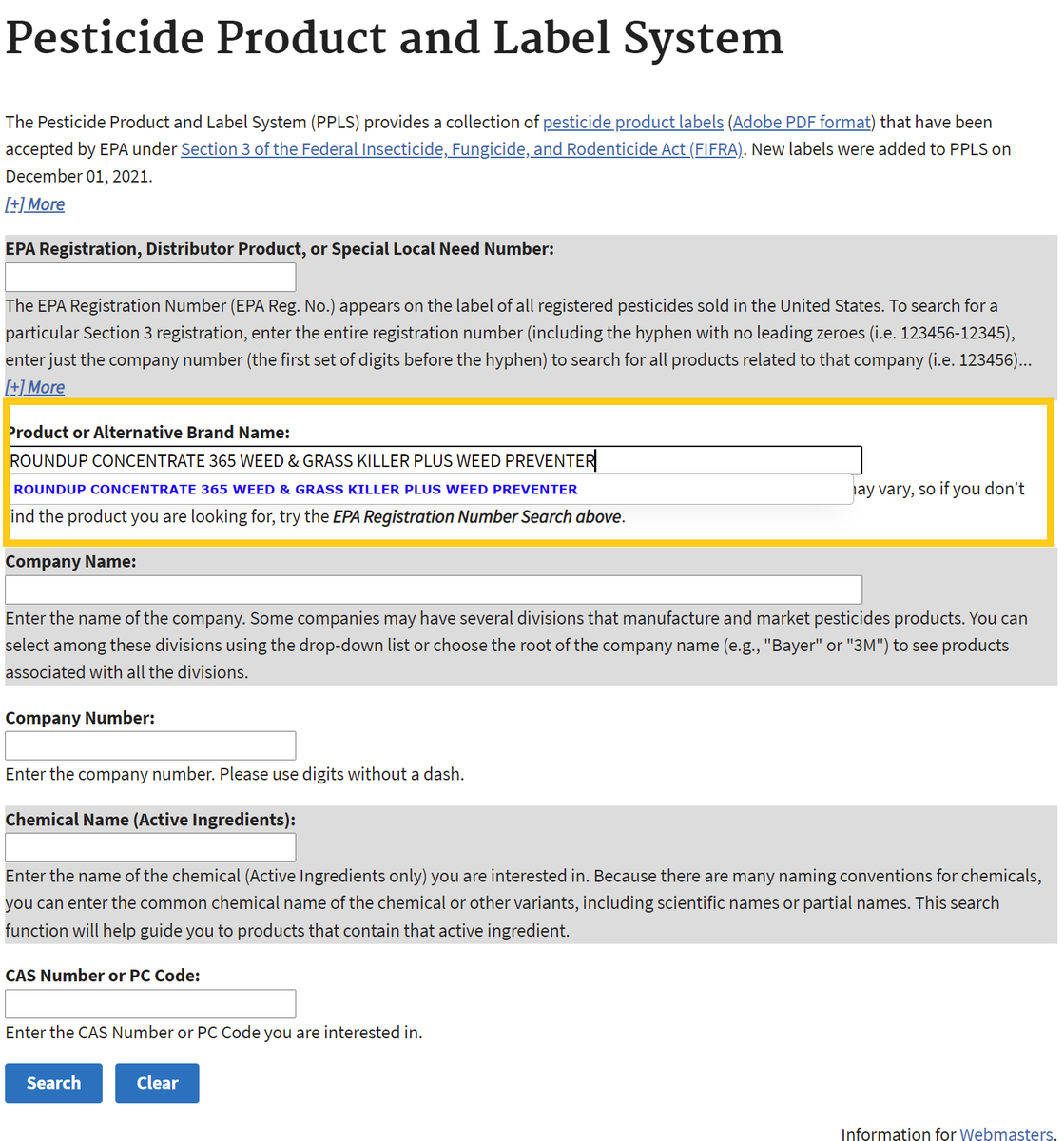
- After searching, click on the chemical ingredients tab or the link for the most recent label to find Active Ingredients.
Chemical List Label List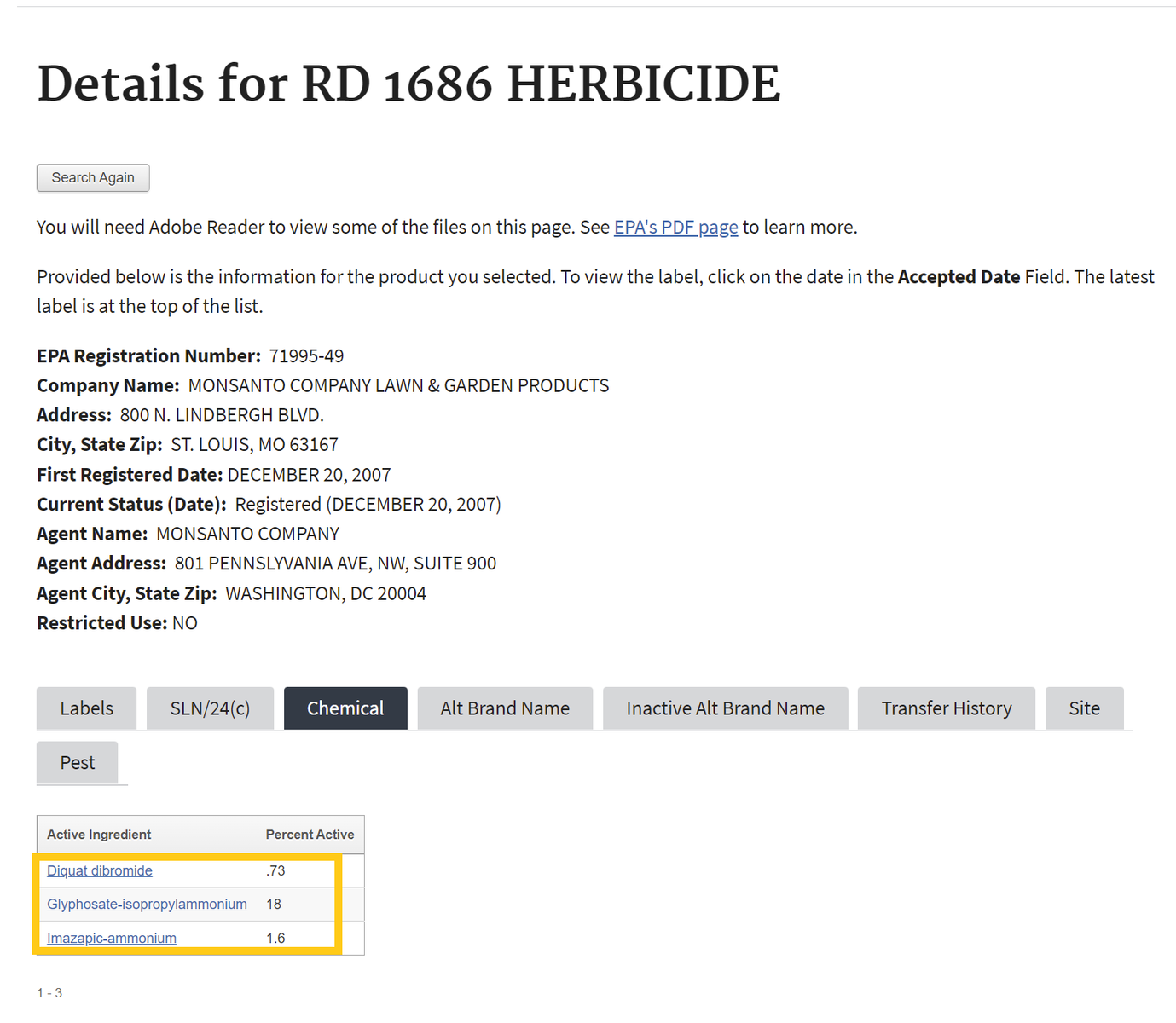
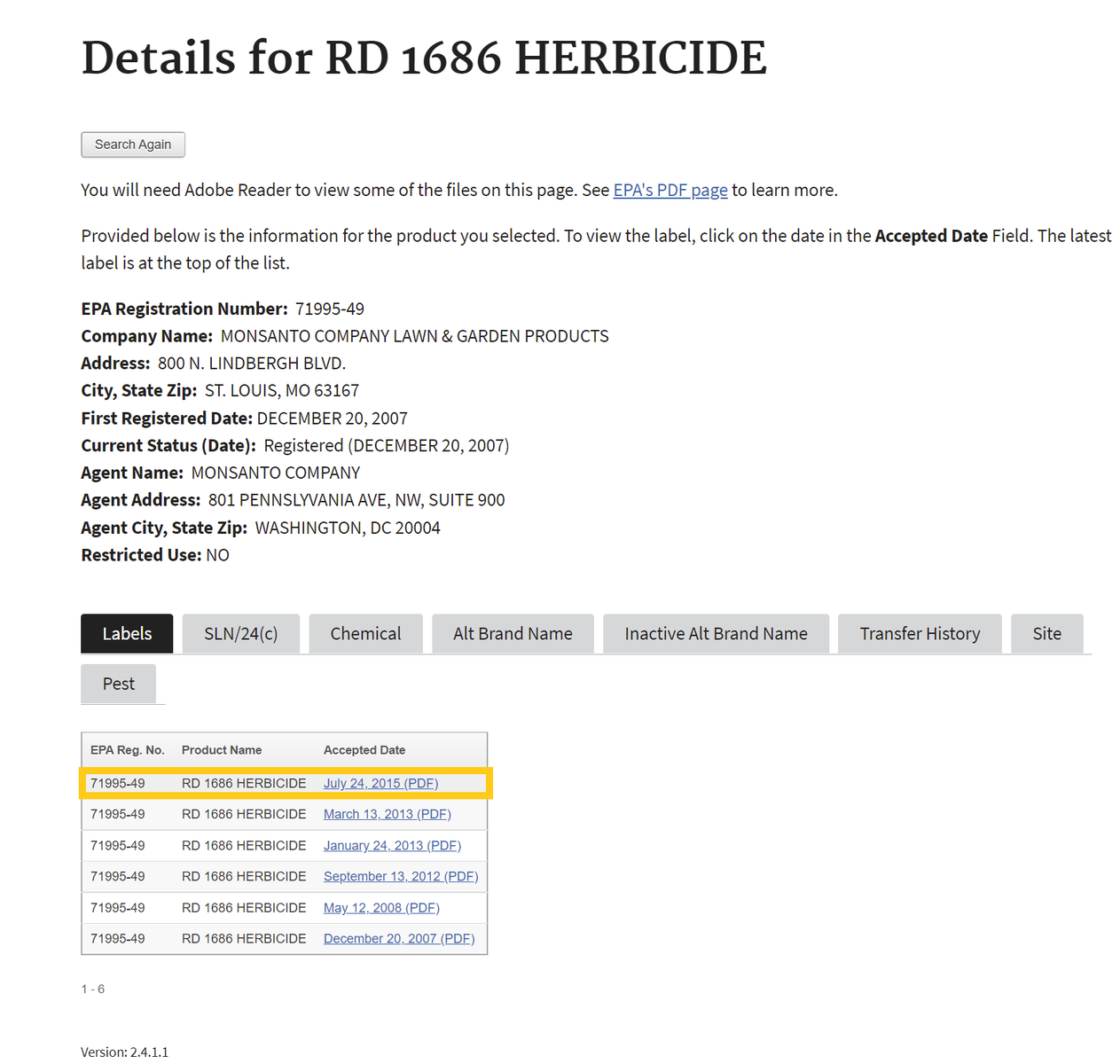
If one selects the chemical ingredients tab, skip to Step 4 . If not, proceed to step number 3 - To find the active ingredient(s) on the label, search for the page in the document containing the date of registration. Usually, the active ingredients section occurs within the first few pages of the label document.
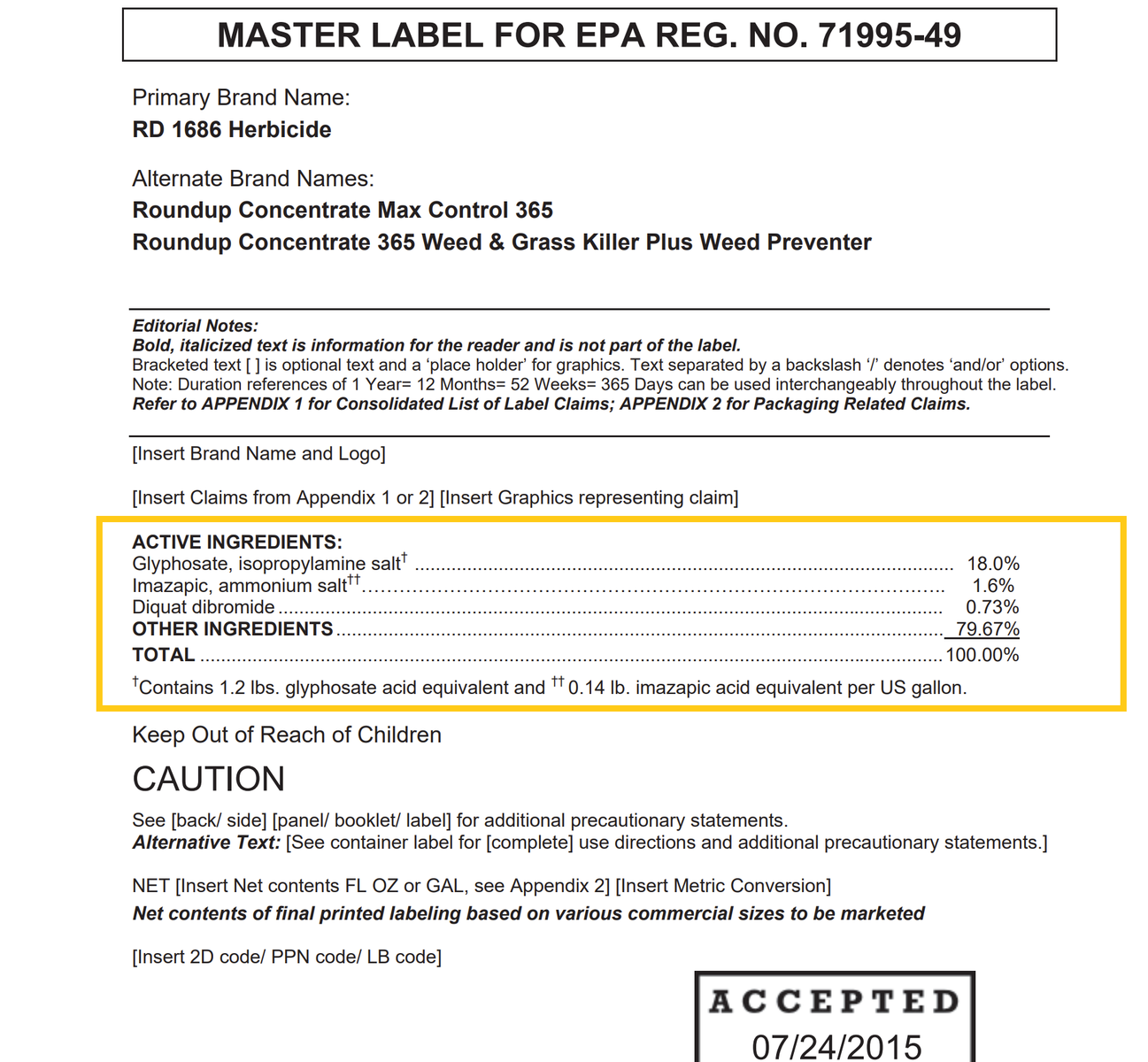
- Return to the Beyond Pesticides Gateway and search for the active ingredient name in the yellow box to the right or from the list below.
Imidacloprid
General Information
- Fact Sheet: Imidacloprid.pdf
- Product Names:
- Chemical Class: Chloro-nicotinyl insecticide
- Uses: Agriculture, lawns and landscapes, pet pests, gardening
- Alternatives: Organic agriculture, Organic lawn care
- Beyond Pesticides rating: Toxic
Health and Environmental Effects
- Cancer: Possible (153, 181)
- Endocrine Disruption: Likely (151, 152)
- Reproductive Effects: Yes (6, 151, 152)
- Neurotoxicity: Possible (154)
- Kidney/Liver Damage: Possible (155, 156)
- Sensitizer/ Irritant: Not documented
- Birth/Developmental: Likely (154)
- Detected in Groundwater: Not documented
- Potential Leacher: Yes (6)
- Toxic to Birds: Yes (4)
- Toxic to Fish/Aquatic Organisms: Yes (4)
- Toxic to Bees: Yes (4)
Residential Uses as Found in the ManageSafe™ Database
- Dandelions
- Tree-boring Caterpillars
- Fleas
- Grubs
- Termites
- Ants
- Chinch Bugs
- Cockroaches
- Hemlock Woolly Adelgid
- Bed Bugs
- Emerald Ash Borer
- Clover
- Thrips
- Whiteflies
- Aphids
- Fire Ants
Additional Information
- Regulatory Status:
- Beyond Pesticides' Testimony (03/2025)
- Beyond Pesticides' Neonicotinoid Comments (October 2024)
- Beyond Pesticides' Preliminary Neonicotioid Ecological Assessments (non-pollinator) comments (04/2018)
- Imidacloprid Registration Review (04/2018)
- Beyond Pesticides' EPA Draft Human Health Risk Assessment comments (11/2017)
- Beyond Pesticides' Aquatic Ecological Assessment comments (07/2017)
- EPA Actions on Pollinators (01/2017)
- Supporting information:
- EU Commission: Neonicotinoids
- EFSA consultation for thiamethoxam (2016)
- Poisoned Waterways (Beyond Pesticides, 2017)
- Net Loss—Economic Efficacy And Costs Of Neonicotinoid Insecticides Used As Seed Coatings: Updates From The United States And Europe (Center for Food Safety, 2016)
- Heavy Costs: Weighing the Value of Neonicotinoid Insecticides in Agriculture (Center for Food Safety, 2014)
- The Xerces Society - Neonicotinoids and Bees
- NCAP Imidacloprid Factsheet (Northwest Coalition for Alternatives to Pesticides)
- PAN Pesticides Database: Imidacloprid (Pesticide Action Network)
- NPIC Imidacloprid Factsheet (National Pesticide Information Center)
- Studies:
- Imidacloprid and chlorpyrifos insecticides impair migratory ability in a seed-eating songbird. Eng, M, Stutchbury, BJM, Morrissey, C. 2017. Scientific Reports7: 15176. DOI:10.1038/s41598-017-15446-x
- Effects of neonicotinoid pesticide exposure on human health: a systematic review. Cimino AM, Boyles AL, Thayer KA, Perry MJ. 2017. Environ Health Perspect. 125:155–162
- Neonicotinoid Insecticides Alter the Gene Expression Profile of Neuron-Enriched Cultures from Neonatal Rat Cerebellum. Kimura-Kuroda, J, Nishito, Y, Yanagisawa, H et al. 2016. Int J Environ Res Public Health. 13(10): 987.
- First national-scale reconnaissance of neonicotinoid insecticides in streams across the U.S.A. Hladik, M.L. and Kolpin, D.W., 2016. Environ. Chem., v. 13, pp. 12-20.
- Neonicotinoid contamination of global surface waters and associated risk to aquatic invertebrates: A review. Morrissey, C. A., Mineau, P, Devries, J, et al. 2015. Environment International. 74 (2015) 291–303.
- Assessing Field‐Scale Risks of Foliar Insecticide Applications to Monarch Butterfly (Danaus plexippus) Larvae. Krishnan, N., Zhang, Y., Bidne, K.G., Hellmich, R.L., Coats, J.R. and Bradbury, S.P., 2020. Environmental Toxicology and Chemistry, 39(4), pp.923-941.
- Autism spectrum disorder, flea and tick medication, and adjustments for exposure misclassification: the CHARGE (CHildhood Autism Risks from Genetics and Environment) case-control study.. Keil AP, Daniels JL, Hertz-Picciotto I. 2014. Environ Health. 13(1):3.
- Early-life chemical exposures and risk of metabolic syndrome.. De Long NE, Holloway AC. 2017. Diabetes Metab Syndr Obes. 10:101-109.
- Imidacloprid Promotes High Fat Diet-Induced Adiposity in Female C57BL/6J Mice and Enhances Adipogenesis in 3T3-L1 Adipocytes via the AMPKα-Mediated Pathway.. Sun Q, Qi W, Xiao X, Yang SH, et al. 2017. J Agric Food Chem. 65(31):6572-6581
- Pesticide occurrence and persistence entering recreational lakes in watersheds of varying land uses. Satiroff, J.A., Messer, T.L., Mittelstet, A.R. and Snow, D.D. Environmental Pollution, 273, p.116399.
- Past insecticide exposure reduces bee reproduction and population growth rate. Stuligross, C. and Williams, N.M. Proceedings of the National Academy of Sciences, 118(48).
- Carryover effects of pesticide exposure and pond drying on performance, behavior, and sex ratios in a pool breeding amphibian. Thompson, C.M., Sweeney, M.R. and Popescu, V.D., 2022. Journal of Zoology.
- Infantile Internal and External Exposure to Neonicotinoid Insecticides: A Comparison of Levels across Various Sources. Zhang, H., Wang, Y., Zhu, H., Lu, S., Wang, Y., Xue, J., Zhang, T., Kannan, K. and Sun, H., 2023. Environmental Science & Technology, 57(13), pp.5358-5367.
- Comparing the effects of three neonicotinoids on embryogenesis of the South African clawed frog Xenopus laevis. Flach, H. et al. (2024) Comparing the effects of three neonicotinoids on embryogenesis of the South African clawed frog xenopus laevis, Current Research in Toxicology. Available at: https://www.sciencedirect.com/science/article/pii/S2666027X24000227?via%3Dihub.
- Major Pesticides Are More Toxic to Human Cells Than Their Declared Active Principles. Mesnage, R. et al. (2014) Major pesticides are more toxic to human cells than their declared active principles, BioMed Research International. Available at: https://www.ncbi.nlm.nih.gov/pmc/articles/PMC3955666/.
- Assessing the ecological impact of pesticides/herbicides on algal communities: A comprehensive review. Narayanan, N. et al. (2024) Assessing the ecological impact of pesticides/herbicides on algal communities: A comprehensive review, Aquatic Toxicology. Available at: https://www.sciencedirect.com/science/article/abs/pii/S0166445X24000225?via%3Dihub.
- The molecular determinants of pesticide sensitivity in bee pollinators. Bass, C. et al (2024) The molecular determinants of pesticide sensitivity in bee pollinators, Science of The Total Environment. Available at: https://www.sciencedirect.com/science/article/pii/S0048969724003097.
- Residues of agrochemicals in beebread as an indicator of landscape management. Bogo, G. et al. (2024) Residues of agrochemicals in beebread as an indicator of landscape management, Science of The Total Environment. Available at: https://www.sciencedirect.com/science/article/abs/pii/S0048969724042232?via%3Dihub.
- Unveiling bee pollen's contamination with pesticides and mycotoxins: Current analytical procedures, results and regulation. Carrera, M. et al. (2024) Unveiling bee pollen’s contamination with pesticides and mycotoxins: Current analytical procedures, results and regulation, Trends in Analytical Chemistry. Available at: https://www.sciencedirect.com/science/article/abs/pii/S0165993624004187.
- Honey Bee (Apis mellifera) Exposure to Pesticide Residues in Nectar and Pollen in Urban and Suburban Environments from Four Regions of the United States. Démares, F.J. et al. (2022) Honey Bee (Apis mellifera) Exposure to Pesticide Residues in Nectar and Pollen in Urban and Suburban Environments from Four Regions of the United States, Environmental Toxicology and Chemistry. Available at: https://setac.onlinelibrary.wiley.com/doi/10.1002/etc.5298.
- Estimating the aquatic risk from exposure to up to twenty-two pesticide active ingredients in waterways discharging to the Great Barrier Reef. Warne, M. et al. (2023) Estimating the aquatic risk from exposure to up to twenty-two pesticide active ingredients in waterways discharging to the Great Barrier Reef, Science of The Total Environment. Available at: https://www.sciencedirect.com/science/article/pii/S0048969723032552.
- Neonicotinoid pesticides: evidence of developmental neurotoxicity from regulatory rodent studies. Sass, J.B., Donley, N. and Freese, W. (2024) Neonicotinoid pesticides: evidence of developmental neurotoxicity from regulatory rodent studies, Frontiers in Toxicology. Available at: https://www.frontiersin.org/journals/toxicology/articles/10.3389/ftox.2024.1438890/full.
- Nationwide Biomonitoring of Neonicotinoid Insecticides in Breast Milk and Health Risk Assessment to Nursing Infants in the Chinese Population. Chen, D. et al. (2020) Nationwide Biomonitoring of Neonicotinoid Insecticides in Breast Milk and Health Risk Assessment to Nursing Infants in the Chinese Population, Journal of Agricultural and Food Chemistry. Available at: https://pubs.acs.org/doi/10.1021/acs.jafc.0c05769.
- Interaction between imidacloprid residues in maize rhizospheric soil and soil nematode community. Zhang, J. et al. (2024) Interaction between imidacloprid residues in maize rhizospheric soil and soil nematode community, Pesticide Biochemistry and Physiology. Available at: https://www.sciencedirect.com/science/article/abs/pii/S0048357524004528.
- Assessment of lethal and sublethal effects of imidacloprid, ethion, and glyphosate on aversive conditioning, motility, and lifespan in honey bees (Apis mellifera L.). Sahar Delkash-Roudsari, Ana M. Chicas-Mosier, Seyed Hossein Goldansaz, Khalil Talebi-Jahromi, Ahmad Ashouri, Charles I. Abramson, Assessment of lethal and sublethal effects of imidacloprid, ethion, and glyphosate on aversive conditioning, motility, and lifespan in honey bees (Apis mellifera L.), Ecotoxicology and Environmental Safety, Volume 204, 2020, 111108, ISSN 0147-6513, https://doi.org/10.1016/j.ecoenv.2020.111108.
- Brain transcriptome of honey bees (Apis mellifera) exhibiting impaired olfactory learning induced by a sublethal dose of imidacloprid. Zhiguo Li, Tiantian Yu, Yanping Chen, Matthew Heerman, Jingfang He, Jingnan Huang, Hongyi Nie, Songkun Su, Brain transcriptome of honey bees (Apis mellifera) exhibiting impaired olfactory learning induced by a sublethal dose of imidacloprid, Pesticide Biochemistry and Physiology, Volume 156, 2019, Pages 36-43, ISSN 0048-3575, https://doi.org/10.1016/j.pestbp.2019.02.001.
- Imidacloprid slows the development of preference for rewarding food sources in bumblebees (Bombus impatiens). Phelps, J.D., Strang, C.G., Gbylik-Sikorska, M. et al. Imidacloprid slows the development of preference for rewarding food sources in bumblebees (Bombus impatiens). Ecotoxicology 27, 175–187 (2018). https://doi.org/10.1007/s10646-017-1883-3
- A neonicotinoid impairs olfactory learning in Asian honey bees (Apis cerana) exposed as larvae or as adults. Tan, K., Chen, W., Dong, S. et al. A neonicotinoid impairs olfactory learning in Asian honey bees (Apis cerana) exposed as larvae or as adults. Sci Rep 5, 10989 (2015). https://doi.org/10.1038/srep10989
- Imidacloprid toxicity impairs spatial memory of echolocation bats through neural apoptosis in hippocampal CA1 and medial entorhinal cortex areas. Hsiao, Chun-Jen; Lin, Ching-Lung; Lin, Tian-Yu; Wang, Sheue-Er; Wu, Chung-Hsin. Imidacloprid toxicity impairs spatial memory of echolocation bats through neural apoptosis in hippocampal CA1 and medial entorhinal cortex areas. NeuroReport 27(6):p 462-468, April 13, 2016. | DOI: 10.1097/WNR.0000000000000562
- Effects of imidacloprid, a neonicotinoid insecticide, on the echolocation system of insectivorous bats. Chung-Hsin Wu, Ching-Lung Lin, Sheue-Er Wang, Chen-Wen Lu, Effects of imidacloprid, a neonicotinoid insecticide, on the echolocation system of insectivorous bats, Pesticide Biochemistry and Physiology, Volume 163, 2020, Pages 94-101, ISSN 0048-3575, https://doi.org/10.1016/j.pestbp.2019.10.010.
- Impact of Endocrine Disrupting Pesticide Use on Obesity: A Systematic Review. Pérez-Bermejo, M. et al. (2024) Impact of Endocrine Disrupting Pesticide Use on Obesity: A Systematic Review, Biomedicines. Available at: https://www.mdpi.com/2227-9059/12/12/2677.
- Widespread Use and Frequent Detection of Neonicotinoid Insecticides in Wetlands of Canada's Prairie Pothole Region. Main, A.R. et al. (2014) Widespread Use and Frequent Detection of Neonicotinoid Insecticides in Wetlands of Canada’s Prairie Pothole Region, PLOS ONE. Available at: https://journals.plos.org/plosone/article?id=10.1371%2Fjournal.pone.0092821.
- Immune response of Brazilian farmers exposed to multiple pesticides . Jacobsen-Pereira, C.H. et al. (2020) ‘Immune response of Brazilian farmers exposed to multiple pesticides’, Ecotoxicology and Environmental Safety, 202, p. 110912. doi:10.1016/j.ecoenv.2020.110912.
- A Th2-type immune response and low-grade systemic inflammatory reaction as potential immunotoxic effects in intensive agriculture farmers exposed to pesticides . Lozano-Paniagua, D. et al. (2024) ‘A th2-type immune response and low-grade systemic inflammatory reaction as potential immunotoxic effects in intensive agriculture farmers exposed to pesticides’, Science of The Total Environment, 938, p. 173545. doi:10.1016/j.scitotenv.2024.173545.
- Pesticide-Induced Inflammation at a Glance. Lopes-Ferreira, M. et al. (2023) ‘Pesticide-induced inflammation at a glance’, Toxics, 11(11), p. 896. doi:10.3390/toxics11110896.
- Neonicotinoids in Connecticut Waters: Surface Water, Groundwater, and Threats to Aquatic Ecosystems . Presley, S.J., Perkins, C.R. and Willig, M.R. (2025) Neonicotinoids in Connecticut Waters: Surface Water, Groundwater, and Threats to Aquatic Ecosystems, Center for Environmental Sciences and Engineering. Available at: https://norwalkriver.org/wp-content/uploads/2025/01/Neonicotinoids-in-Connecticut-Final-Report-1-11-2025-1.pdf.
- Hormetic response to pesticides in diapausing bees. Amsalem, E., Derstine, N. and Murray, C. (2025) Hormetic response to pesticides in diapausing bees, Biology Letters. Available at: https://royalsocietypublishing.org/doi/full/10.1098/rsbl.2024.0612.
- Differential responses of Apis mellifera heat shock protein genes to heat shock, flower-thinning formulations, and imidacloprid. Koo, J. et al. (2015) Differential responses of apis mellifera heat shock protein genes to heat shock, flower-thinning formulations, and imidacloprid, Journal of Asia-Pacific Entomology. Available at: https://www.sciencedirect.com/science/article/abs/pii/S1226861515000813.
- Pesticide exposure and sleep disorder: A cross-sectional study among Thai farmers. Juntarawijit, C. et al. (2025) Pesticide exposure and sleep disorder: A cross-sectional study among Thai farmers, Heliyon. Available at: https://www.cell.com/heliyon/fulltext/S2405-8440(24)17154-X.
- Neonicotinoid exposure causes behavioral impairment and delayed mortality of the federally threatened American burying beetle, Nicrophorus americanus. Cavallaro, M. et al. (2025) Neonicotinoid exposure causes behavioral impairment and delayed mortality of the federally threatened American burying beetle, Nicrophorus americanus, PLOS One. Available at: https://journals.plos.org/plosone/article?id=10.1371%2Fjournal.pone.0314243.
- Lethal and sublethal effects of seven insecticides on three beneficial insects in laboratory assays and field trials. Fernandes, M. et al. (2016) Lethal and sublethal effects of seven insecticides on three beneficial insects in laboratory assays and field trials, Chemosphere. Available at: https://www.sciencedirect.com/science/article/abs/pii/S0045653516306051.
- Chronic exposure to insecticides impairs honeybee optomotor behaviour. Parkinson, R., Fecher, C. and Gray, J. (2022) Chronic exposure to insecticides impairs honeybee optomotor behaviour, Frontiers in Insect Science. Available at: https://www.frontiersin.org/journals/insect-science/articles/10.3389/finsc.2022.936826/full.
- High prevalence of veterinary drugs in bird's nests. Tassin de Montaigu, C. et al. (2025) High prevalence of veterinary drugs in bird’s nests, Science of The Total Environment. Available at: https://www.sciencedirect.com/science/article/pii/S0048969725000737.
- Field evidence of bird poisonings by imidacloprid-treated seeds: a review of incidents reported by the French SAGIR network from 1995 to 2014. Millot, F., Decors, A., Mastain, O. et al. Field evidence of bird poisonings by imidacloprid-treated seeds: a review of incidents reported by the French SAGIR network from 1995 to 2014. Environ Sci Pollut Res 24, 5469–5485 (2017). https://doi.org/10.1007/s11356-016-8272-y
- Residues and Bioavailability of Neonicotinoid Pesticide in Shaanxi Agricultural Soil. Hua, L., Zhao, D., Wang, H. et al. Residues and Bioavailability of Neonicotinoid Pesticide in Shaanxi Agricultural Soil. Water Air Soil Pollut 234, 129 (2023). https://doi.org/10.1007/s11270-023-06159-1
- Combined ecotoxicological effects of different-sized polyethylene microplastics and imidacloprid on the earthworms (Eisenia fetida). Fu, H., Zhu, L., Mao, L., Zhang, L., Zhang, Y., Chang, Y., Liu, X., & Jiang, H. (2023). Combined ecotoxicological effects of different-sized polyethylene microplastics and imidacloprid on the earthworms (Eisenia fetida). The Science of the total environment, 870, 161795. https://doi.org/10.1016/j.scitotenv.2023.161795
- Imidacloprid increases intestinal permeability by disrupting tight junctions. Zhao, G. P., Wang, X. Y., Li, J. W., Wang, R., Ren, F. Z., Pang, G. F., & Li, Y. X. (2021). Imidacloprid increases intestinal permeability by disrupting tight junctions. Ecotoxicology and environmental safety, 222, 112476. https://doi.org/10.1016/j.ecoenv.2021.112476
- Synergistic effect of ZnO NPs and imidacloprid on liver injury in male ICR mice: Increase the bioavailability of IMI by targeting the gut microbiota. Yan, S., Tian, S., Meng, Z., Sun, W., Xu, N., Jia, M., Huang, S., Wang, Y., Zhou, Z., Diao, J., & Zhu, W. (2022). Synergistic effect of ZnO NPs and imidacloprid on liver injury in male ICR mice: Increase the bioavailability of IMI by targeting the gut microbiota. Environmental pollution (Barking, Essex : 1987), 294, 118676. https://doi.org/10.1016/j.envpol.2021.118676
- Current-use pesticides in vegetation, topsoil and water reveal contaminated landscapes of the Upper Rhine Valley, Germany. Mauser, K.M., Wolfram, J., Spaak, J.W. et al. Current-use pesticides in vegetation, topsoil and water reveal contaminated landscapes of the Upper Rhine Valley, Germany. Commun Earth Environ 6, 166 (2025). https://doi.org/10.1038/s43247-025-02118-2
- Prenatal residential proximity to endocrine disrupting agricultural pesticides and menstrual cycle characteristics among Latina adolescents in California. Paul, J. et al. (2025) Prenatal residential proximity to endocrine disrupting agricultural pesticides and menstrual cycle characteristics among Latina adolescents in California, American Journal of Epidemiology. Available at: https://academic.oup.com/aje/advance-article/doi/10.1093/aje/kwaf059/8083004.
- Molecular Basis for Endocrine Disruption by Pesticides Targeting Aromatase and Estrogen Receptor. Zhang, C., Schilirò, T., Gea, M., Bianchi, S., Spinello, A., Magistrato, A., Gilardi, G., & Di Nardo, G. (2020). Molecular Basis for Endocrine Disruption by Pesticides Targeting Aromatase and Estrogen Receptor. International journal of environmental research and public health, 17(16), 5664. https://doi.org/10.3390/ijerph17165664
- Testicular deficiency associated with exposure to cypermethrin, imidacloprid, and chlorpyrifos in adult rats. Abdel-Razik, R. K., Mosallam, E. M., Hamed, N. A., Badawy, M. E. I., & Abo-El-Saad, M. M. (2021). Testicular deficiency associated with exposure to cypermethrin, imidacloprid, and chlorpyrifos in adult rats. Environmental toxicology and pharmacology, 87, 103724. https://doi.org/10.1016/j.etap.2021.103724
- Adverse Effects of Pesticides on the Ovary: Evidence from Epidemiological and Toxicological Studies. Wang, L., Ma, X. and Liu, J. (2025) Adverse Effects of Pesticides on the Ovary: Evidence from Epidemiological and Toxicological Studies, Environment & Health. Available at: https://pubs.acs.org/doi/full/10.1021/envhealth.4c00243.
- Toxicological impact of technical imidacloprid on ovarian morphology, hormones and antioxidant enzymes in female rats. Kapoor, U., Srivastava, M. K., & Srivastava, L. P. (2011). Toxicological impact of technical imidacloprid on ovarian morphology, hormones and antioxidant enzymes in female rats. Food and chemical toxicology : an international journal published for the British Industrial Biological Research Association, 49(12), 3086–3089. https://doi.org/10.1016/j.fct.2011.09.009
- Effect of Imidacloprid on Reproduction of Female Albino Rats in Three Generation Study. Sood, Prerna & Khera, Kuldeep. (2016). Effect of Imidacloprid on Reproduction of Female Albino Rats in Three Generation Study. Journal of Veterinary Science and Technology. 7. 340.
- Effect of imidacloprid on antioxidant status and histopathological changes in ovary and uterus of adult female wistar rats. Lohiya, Archana & Kumar, Vinod & Punia, J.S.. (2018). Effect of imidacloprid on antioxidant status and histopathological changes in ovary and uterus of adult female wistar rats. Indian Journal of Animal Research. 10.18805/ijar.B-3613.
- The effects analysis of two neonicotinoid insecticides on in vitro maturation of porcine oocytes using hanging drop monoculture method. Ishikawa, S., Hiraga, K., Hiradate, Y., & Tanemura, K. (2015). The effects analysis of two neonicotinoid insecticides on in vitro maturation of porcine oocytes using hanging drop monoculture method. The Journal of veterinary medical science, 77(6), 725–728. https://doi.org/10.1292/jvms.15-0008
- Systemic insecticides (neonicotinoids and fipronil): trends, uses, mode of action and metabolites. Simon-Delso, N., Amaral-Rogers, V., Belzunces, L.P. et al. Systemic insecticides (neonicotinoids and fipronil): trends, uses, mode of action and metabolites. Environ Sci Pollut Res 22, 5–34 (2015). https://doi.org/10.1007/s11356-014-3470-y
- Pet dogs transfer veterinary medicines to the environment. Diepens, Noël & Belgers, Dick & Buijse-Bogdan, Laura & Roessink, Ivo. (2022). Pet dogs transfer veterinary medicines to the environment. Science of The Total Environment. 858. 159550. 10.1016/j.scitotenv.2022.159550.
- Pesticide contamination in indoor home dust: A pilot study of non-occupational exposure in Argentina. Aparicio, Virginia & Kaseker, Jessica & Scheepers, Paul & Alaoui, Abdallah & Figueiredo, Daniel & Mol, H. & Silva, Vera & Harkes, Paula & dos Santos, Danilo & Geissen, Violette & Costa, José. (2025). Pesticide Contamination in Indoor Home Dust: A Pilot Study of Non-Occupational Exposure in Argentina. Environmental Pollution. 373. 126208. 10.1016/j.envpol.2025.126208.
- Learning performances of honeybees (Apis mellifera L) are differentially affected by imidacloprid according to the season. Decourtye, A., Lacassie, E. and Pham-Delègue, M.-H. (2003), Learning performances of honeybees (Apis mellifera L) are differentially affected by imidacloprid according to the season. Pest. Manag. Sci., 59: 269-278. https://doi.org/10.1002/ps.631
- Chronic oral exposure to field-realistic pesticide combinations via pollen and nectar: effects on feeding and thermal performance in a solitary bee. Azpiazu, C., Bosch, J., Viñuela, E. et al. Chronic oral exposure to field-realistic pesticide combinations via pollen and nectar: effects on feeding and thermal performance in a solitary bee. Sci Rep 9, 13770 (2019). https://doi.org/10.1038/s41598-019-50255-4
- Do novel insecticides pose a threat to beneficial insects?. Siviter Harry and Muth Felicity 2020 Do novel insecticides pose a threat to beneficial insects?Proc. R. Soc. B.28720201265 http://doi.org/10.1098/rspb.2020.1265
- Comparing the Acute Toxicity of Imidacloprid with Alternative Systemic Insecticides in the Aquatic Insect Chironomus dilutus. Erin M. Maloney, Hunter Sykes, Christy Morrissey, Kerry M. Peru, John V. Headley, Karsten Liber, Comparing the Acute Toxicity of Imidacloprid with Alternative Systemic Insecticides in the Aquatic Insect Chironomus dilutus, Environmental Toxicology and Chemistry, Volume 39, Issue 3, 1 March 2020, Pages 587–594, https://doi.org/10.1002/etc.4639
- Effects of imidacloprid, a neonicotinoid pesticide, on reproduction in worker bumble bees (Bombus terrestris). Laycock, I., Lenthall, K.M., Barratt, A.T. et al. Effects of imidacloprid, a neonicotinoid pesticide, on reproduction in worker bumble bees (Bombus terrestris). Ecotoxicology 21, 1937–1945 (2012). https://doi.org/10.1007/s10646-012-0927-y
- Acute toxicity of 6 neonicotinoid insecticides to freshwater invertebrates. Raby, M., Nowierski, M., Perlov, D., Zhao, X., Hao, C., Poirier, D. G., & Sibley, P. K. (2018). Acute toxicity of 6 neonicotinoid insecticides to freshwater invertebrates. Environmental toxicology and chemistry, 37(5), 1430–1445. https://doi.org/10.1002/etc.4088
- Neonicotinoid mixture alters trophic interactions in a freshwater aquatic invertebrate community. Duchet, C., Hou, F., Sinclair, C. A., Tian, Z., Kraft, A., Kolar, V., Kolodziej, E. P., McIntyre, J. K., & Stark, J. D. (2023). Neonicotinoid mixture alters trophic interactions in a freshwater aquatic invertebrate community. The Science of the total environment, 897, 165419. https://doi.org/10.1016/j.scitotenv.2023.165419
- Sub-lethal Effects of Imidacloprid on Nile Tilapia (Oreochromis niloticus). Günal, A.Ç., Erkmen, B., Paçal, E. et al. Sub-lethal Effects of Imidacloprid on Nile Tilapia (Oreochromis niloticus). Water Air Soil Pollut 231, 4 (2020). https://doi.org/10.1007/s11270-019-4366-8
- The Effect of Neonicotinoids Exposure on Oreochromis niloticus Histopathological Alterations and Genotoxicity. El-Garawani, I.M., Khallaf, E.A., Alne-na-ei, A.A. et al. The Effect of Neonicotinoids Exposure on Oreochromis niloticus Histopathological Alterations and Genotoxicity. Bull Environ Contam Toxicol 109, 1001–1009 (2022). https://doi.org/10.1007/s00128-022-03611-6
- Liver alterations in Oreochromis niloticus (Pisces) induced by insecticide imidacloprid: Histopathology and heat shock protein in situ localization. Ansoar-Rodríguez, Y. et al. (2016) ‘Liver alterations in Oreochromis niloticus (Pisces) induced by insecticide imidacloprid: Histopathology and heat shock protein in situ localization’, Journal of Environmental Science and Health, Part B, 51(12), pp. 881–887. doi: 10.1080/03601234.2016.1240559.
- Systematic assessments of ecological and health risks of soil pesticide residues. Tang, T. et al. (2025) Systematic assessments of ecological and health risks of soil pesticide residues, Environmental Pollution. Available at: https://www.sciencedirect.com/science/article/abs/pii/S0269749125007213.
- Assessment of genetic damage levels in agricultural workers exposed to pesticides in Paraíba, Brazil. Carvalho-Gonçalves, L. et al. (2025) Assessment of genetic damage levels in agricultural workers exposed to pesticides in Paraíba, Brazil, Environmental Toxicology and Pharmacology. Available at: https://www.sciencedirect.com/science/article/abs/pii/S1382668925000900.
- Acute toxicity of neonicotinoid insecticides to ground beetles (Coleoptera: Carabidae) from Pennsylvania. Pearsons, K. and Tooker, J. (2025) Acute toxicity of neonicotinoid insecticides to ground beetles (Coleoptera: Carabidae) from Pennsylvania, Environmental Entomology. Available at: https://academic.oup.com/ee/advance-article-abstract/doi/10.1093/ee/nvaf048/8128784.
- Toxic and Behavioral Effects to Carabidae of Seed Treatments Used on Cry3Bb1- and Cry1Ab/c-Protected Corn. Christopher A. Mullin, Michael C. Saunders, Timothy W. Leslie, David J. Biddinger, Shelby J. Fleischer, Toxic and Behavioral Effects to Carabidae of Seed Treatments Used on Cry3Bb1- and Cry1Ab/c-Protected Corn, Environmental Entomology, Volume 34, Issue 6, 1 December 2005, Pages 1626–1636, https://doi.org/10.1603/0046-225X-34.6.1626
- Toxicity of imidacloprid to the terrestrial isopod Porcellio scaber (Isopoda, Crustacea). Drobne, D., Blazic, M., Van Gestel, C. A., Leser, V., Zidar, P., Jemec, A., & Trebse, P. (2008). Toxicity of imidacloprid to the terrestrial isopod Porcellio scaber (Isopoda, Crustacea). Chemosphere, 71(7), 1326–1334. https://doi.org/10.1016/j.chemosphere.2007.11.042
- An assessment of exposure to several classes of pesticides in pet dogs and cats from New York, United States. Li, Z. M., Robinson, M., & Kannan, K. (2022). An assessment of exposure to several classes of pesticides in pet dogs and cats from New York, United States. Environment international, 169, 107526. https://doi.org/10.1016/j.envint.2022.107526
- Inputs, source apportionment, and transboundary transport of pesticides and other polar organic contaminants along the lower Red River, Manitoba, Canada. Challis, J. K., Cuscito, L. D., Joudan, S., Luong, K. H., Knapp, C. W., Hanson, M. L., & Wong, C. S. (2018). Inputs, source apportionment, and transboundary transport of pesticides and other polar organic contaminants along the lower Red River, Manitoba, Canada. The Science of the total environment, 635, 803–816. https://doi.org/10.1016/j.scitotenv.2018.04.128
- Occurrence of Current-Use Pesticides in Paired Indoor Dust, Drinking Water, and Urine Samples from the United States: Risk Prioritization and Health Implications. Xie, Y., Li, J., Salamova, A., & Zheng, G. (2025). Occurrence of Current-Use Pesticides in Paired Indoor Dust, Drinking Water, and Urine Samples from the United States: Risk Prioritization and Health Implications. Environmental science & technology, 59(25), 12507–12519. https://doi.org/10.1021/acs.est.5c00961
- A wild bumble bee shows intraspecific differences in sensitivity to multiple pesticides. Tatarko, A. et al. (2025) A wild bumble bee shows intraspecific differences in sensitivity to multiple pesticides, Royal Society Open Science. Available at: https://royalsocietypublishing.org/doi/10.1098/rsos.250281.
- Toxic temperatures: Bee behaviours exhibit divergent pesticide toxicity relationships with warming. Kenna, D., Graystock, P., & Gill, R. J. (2023). Toxic temperatures: Bee behaviours exhibit divergent pesticide toxicity relationships with warming. Global Change Biology, 29, 2981–2998. https://doi.org/10.1111/gcb.16671
- Urinary pesticide biomarkers from adolescence to young adulthood in an agricultural setting in Ecuador: Study of secondary exposure to pesticides among children, adolescents, and adults (ESPINA) 2016 and 2022 examination data. Parajuli, R. et al. (2025) Urinary pesticide biomarkers from adolescence to young adulthood in an agricultural setting in Ecuador: Study of secondary exposure to pesticides among children, adolescents, and adults (ESPINA) 2016 and 2022 examination data, Data in Brief. Available at: https://www.sciencedirect.com/science/article/pii/S2352340925006067.
- Exposure to multiple neonicotinoid insecticides, oxidative stress, and gestational diabetes mellitus: Association and potential mediation analyses. Mahai, Gaga et al. “Exposure to multiple neonicotinoid insecticides, oxidative stress, and gestational diabetes mellitus: Association and potential mediation analyses.” Environment international vol. 179 (2023): 108173. doi:10.1016/j.envint.2023.108173
- Varroa destructor infestation amplifies imidacloprid vulnerability in Apis mellifera. Wang, Y. et al. (2025) Varroa destructor infestation amplifies imidacloprid vulnerability in Apis mellifera, Pesticide Biochemistry and Physiology. Available at: https://www.sciencedirect.com/science/article/abs/pii/S0048357525003293.
- Pesticides residues and metabolites in honeybees: A Greek overview exploring Varroa and Nosema potential synergies. Kasiotis, Konstantinos M et al. “Pesticides residues and metabolites in honeybees: A Greek overview exploring Varroa and Nosema potential synergies.” The Science of the total environment vol. 769 (2021): 145213. doi:10.1016/j.scitotenv.2021.145213
- Immune gene expression in developing honey bees (Apis mellifera L.) simultaneously exposed to imidacloprid and Varroa destructor in laboratory conditions. Tesovnik, T. et al. (2019) ‘Immune gene expression in developing honey bees (Apis mellifera L.) simultaneously exposed to imidacloprid and Varroa destructor in laboratory conditions’, Journal of Apicultural Research, 58(5), pp. 730–739. doi: 10.1080/00218839.2019.1634463.
- Early life imidacloprid and copper exposure affects the gut microbiome, metabolism, and learning ability of honey bees (Apis mellifera). Li, Xijie et al. “Early life imidacloprid and copper exposure affects the gut microbiome, metabolism, and learning ability of honey bees (Apis mellifera).” Environmental research vol. 273 (2025): 121134. doi:10.1016/j.envres.2025.121134
- Pesticide exposure in honey bees results in increased levels of the gut pathogen Nosema. Pettis, J.S., vanEngelsdorp, D., Johnson, J. et al. Pesticide exposure in honey bees results in increased levels of the gut pathogen Nosema . Naturwissenschaften 99, 153–158 (2012). https://doi.org/10.1007/s00114-011-0881-1
- Impaired Olfactory Associative Behavior of Honeybee Workers Due to Contamination of Imidacloprid in the Larval Stage. Yang EC, Chang HC, Wu WY, Chen YW (2012) Impaired Olfactory Associative Behavior of Honeybee Workers Due to Contamination of Imidacloprid in the Larval Stage. PLOS ONE 7(11): e49472. https://doi.org/10.1371/journal.pone.0049472
- Imidacloprid-induced facilitation of the proboscis extension reflex habituation in the honeybee. Lambin, M., Armengaud, C., Raymond, S. and Gauthier, M. (2001), Imidacloprid-induced facilitation of the proboscis extension reflex habituation in the honeybee. Arch. Insect Biochem. Physiol., 48: 129-134. https://doi.org/10.1002/arch.1065
- Imidacloprid impairs memory and brain metabolism in the honeybee (Apis mellifera L.). Decourtye, Axel & Armengaud, Catherine & Renou, Michel & Devillers, James & Cluzeau, Sophie & Gauthier, Monique & Pham-Delègue, Minh-Hà. (2004). Imidacloprid impairs memory and brain metabolism in the honeybee (Apis mellifera L.). Pesticide Biochemistry and Physiology. 78. 83-92. 10.1016/j.pestbp.2003.10.001.
- Sublethal effects of imidacloprid-contaminated honey stores on colony performance, queens, and worker activities in fall and early winter colonies. Carroll MJ, Brown NJ, Reitz D (2024) Sublethal effects of imidacloprid-contaminated honey stores on colony performance, queens, and worker activities in fall and early winter colonies. PLOS ONE 19(1): e0292376. https://doi.org/10.1371/journal.pone.0292376
- Sub-lethal effects of six neonicotinoids on avoidance behavior and reproduction of earthworms (Eisenia fetida). Ge, Jing et al. “Sub-lethal effects of six neonicotinoids on avoidance behavior and reproduction of earthworms (Eisenia fetida).” Ecotoxicology and environmental safety vol. 162 (2018): 423-429. doi:10.1016/j.ecoenv.2018.06.064
- Occurrence and ecological risk of typical pesticides in a river–lake system. Qin, Y. et al. (2025) Occurrence and ecological risk of typical pesticides in a river–lake system, Water Science and Engineering. Available at: https://www.sciencedirect.com/science/article/pii/S1674237025000833.








.png)
